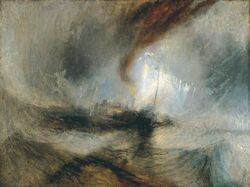Philosophy:Digital sublime
This article contains wording that promotes the subject in a subjective manner without imparting real information. (December 2020) (Learn how and when to remove this template message) |
The Digital sublime is the mythologization of the impact of computers and cyberspace on human experiences of time, space and power. It is a philosophical conception of the awe and terror that captivate the collective conscience with the emergence of these new technologies and the promises and predictions that flow from it. These can be either utopian or dystopic depending on the individual's interpretation of their emotional response.
Development and Distinction from the Classical Notion of the Sublime
The Classical Notion of the Sublime
The classical notion of the sublime was fathered by Immanuel Kant in his work Observations on the Feeling of the Beautiful and Sublime (1764).[1] He defined the Sublime in his piece Critique of Judgment (1790) as:
“an object (of nature) the presentation of which determines the mind to think of nature's inability to attain to an exhibition of ideas.”[2]
The nature of the classical sublime according to Kant was the sensation produced in the individual when confronted with something that:
- Was beyond the realms of the mind's comprehension
- Overawed the imagination
The result was an overwhelming sense of empowerment at being able to stand before such a spectacle and exhilaration at how fragile a person is in the face of such tremendous power and immensity.[3] Examples for Kant were standing before a mountain or overlooking the raging sea.[4]
Edmund Burke's (1756) work, "Philosophical Enquiry into the Origin of Our Ideas of the Sublime and Beautifiul" is another contributor to this classical notion, writing at a similar time to Kant. For him the sublime emerges from the terrible or that which invokes terror.[5]
Origins of the Digital Sublime
Vincent Mosco is one of the leading thinkers in the development and distinction of the digital sublime as highly respected academic amongst the international community and is currently a Professor at Queen's University in Canada.[6] His seminal work "The Digital Sublime: Myth, Power, and Cyberspace"[7] explains that the digital sublime did not have a definite beginning. However, he outlines how it emerged as a progression from the technological sublime, which was the beginning of a shift in conceptions of the sublime connected to the industrial revolutions of the late 19th century and early 20th Century. Inventions such as the railroad, electricity, the radio and the aeroplane all captivated the collective conscience in the possibility of the ushering in of a global village.
Mosco argues that there has not been a significant change in our approach to the appearance of new technologies, with the same prophesies of revolutionising the human experience of time, space and power, even to the extent of ending world conflict. Mosco identifies these same promises heralded in relation to Computers and Cyberspace. The digital revolution and information revolution are captivating the imagination and attention of global onlookers in an almost identical fashion.
Skowronska, an emerging academic from the University of Sydney and contemporary artist,[8] proposes that it was with the emergence of new technologies such as graphics cards for video games, opens source programs, three dimensional computer processing engines, the digital video screen and others opened up whole new possibilities of virtuality as a creative tool.[9] She proposes that is was in the ability of these technologies to represent the invisible that truly distinguished the digital sublime from its classical notion and that it did so "through a virtual channel of mathematical coding, or algorithms, that act as correlates for this invisible world, translating it into a visual field perceptible by human optics".[10]
Artistic Expression
The classical notion of the sublime has been represented by various artists such as Joseph Mallord William Turner drawing off the inspiration described by both Kant and Burke, that is the natural world.[11]
Artwork on the digital sublime has now emerged attempting to capture our awe and excitement around Big Data, New Media and Web 2.0. Huang proposes that the digital sublime in artistic expression is the representation of something unpresentable.[12] A prime example of this is digital composite-photography which involves stitching photographs together to create images that would not be possible without recent technology in order to conceptualise complex ideas through image.
Skowronska, however, associates the digital sublime in art as a move away from the massive to the minutiae. She proposes that the representation of what is not physically perceptible to the eye, but that has a representation in the virtual facilitated by new technology is the distinctive mark of this art form. She has done significant work of her own in this field as well as developing the digital sublime conceptually through her thesis. He individual work focuses on the manipulation, projection and representation of data through different digital forms.
Criticisms of the Digital Sublime
The digital sublime, for some theorists, is not only unhelpful in understanding and engaging with new technology, but they believe that Mosco's myths inhibit and endanger cyberculture in a way that Burkart likens to the endangerment of biodiversity. Such theorists argue that the digital sublime blinds users to the risks and vulnerabilities of cyberspace.[13]
The Digital Sublime and Political Economy
The Digital Sublime has been taken by media theorists to obscure and obfuscate the interworking of Web 2.0. Media theorists have worked to critically analyse and evaluate the processes, algorithms, and functions behind the user interface in order to unveil the driving forces of development and updates online. Political economic theorists have proposed that as opposed to the myths espoused by the digital sublime of the internet providing a faultless user experience providing everything desired at the user's fingertips, that in reality this is far from the truth. Behind the surface, business owners are manipulating the infrastructure and digital architecture of platforms in order create the most profit.[14]
The Digital Sublime and the Music Industry
The digital sublime has seemingly encouraged the narrative that streaming services and cloud based storage will lead to unprecedented freedom and access music. While it is true that our physical limitations in access to music content has been reduced to the requirement of having an electronic device with internet connection, the truthfulness of this emancipation has been brought under scrutiny.
Patrick Burkart is another prominent academic and editor in chief of the International Journal of Media and Culture[15] and he proposes that the emancipation of content is limited to that of the mobilisation of content. As opposed to freeing up content, access is still limited by algorithms giving preference to more popular content and consequently further obscuring the greater diversity of content that is actually available. Instead, he argues that it is those who disrupt our perception of the seamless and all encompassing nature of music streaming services that reveal to us the technical and legal barriers that benefit content providers and are limiting, even shepherding, user experience so as to meet their goals.[16] He sees pirates of media content as the key dissenters to this otherwise invisible vertical integration and that they are symptomatic of the fragility of cyber-communities.
References
- ↑ Scott, Joe WT (July 2015). > ""The majesty of desolation": Ryoji Ikeda's digital sublime". Kerb: Journal of Landscape Architecture 23: 18–21. https://search-informit-com-au.ezproxy1.library.usyd.edu.au/documentSummary;dn=447232706555047;res=IELHSS>.
- ↑ Kant, Immanuel (1987). The Critique of Judgment. Indianapolis: Hackett Publishing Company. pp. 232. https://archive.org/details/critiquejudgment00kant.
- ↑ Most, Glenn (2012). The Sublime, Today? In Dynamic Reading: Studies in the Reception of Epicureanism. Oxford University Press. pp. 244. ISBN 9780199794959.
- ↑ Kant, Immanuel (1987). The Critique of Judgement. Indianapolis: Hackett Publishing Company. pp. 256. https://archive.org/details/critiquejudgment00kant.
- ↑ Burke, Edmund (1998). A philosophical enquiry into the origin of our ideas of the sublime and beautiful. New York: Oxford University Press.
- ↑ Mosco, Vincent. "About". http://www.vincentmosco.com/about.html.
- ↑ Mosco, Vincent (2004). The Digital Sublime: Myth, Power, and Cyberspace. Cambridge: The MIT Press.
- ↑ "elwira skowrońska" (in en-US). https://www.elwiraskowronska.com/.
- ↑ Skowronska, Elwira (2018). datascapes: Redefining the Sublime in Contemporary Art. Sydney: The University of Sydney, School of Literature, Arts and Media.
- ↑ Skowronska, Elwira (2018). datascapes: Redefining the Sublime in Contemporary Art. Sydney: The University of Sydney, School of Literature, Arts and Media. pp. 17.
- ↑ "Kant's Aesthetics and Teleology". 2005. https://plato.stanford.edu/entries/kant-aesthetics/#2.7.
- ↑ Huang, Yi-Hui (2012). "The Digital Sublime: Lessons from Kelli Connell's Double Life". Journal of Aesthetic Education 46: 70–79. doi:10.5406/jaesteduc.46.4.0070.
- ↑ McDevitt & Sindorff (2012). "How to Kill a Journalism School: The Digital Sublime in the Discourse of Discontinuance". Journalism and Mass Communication Educator 67: 109–118. doi:10.1177/1077695812440942.
- ↑ Hutchins, Brett (2016). "Tales of the digital sublime: Tracing the relationship between big data and professional sport". Convergence: The International Journal of Research into New Media Technologies 22: 494–509. doi:10.1177/1354856515587163.
- ↑ "Patrick Burkart | Texas A&M University - Academia.edu". https://tamu.academia.edu/PatrickBurkart.
- ↑ Burkart, Patrick (2014). "Music in the Cloud and the Digital Sublime". Popular Music and Society 37 (4): 393–407. doi:10.1080/03007766.2013.810853.
 |




